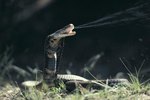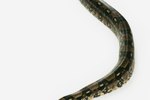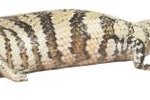
Not all lizards have split or forked tongues -- in fact, the only ones that do are monitors. Monitors use their tongues in ways drastically different from how we use our tongues. He doesn't use his forked tongue for savoring the flavor of his dinner -- in fact, he typically uses it as a way of finding dinner in the first place. It's an invaluable tool for navigating his environment, and without it, he may be relatively directionless.
Types of Tongues
The key to understanding a monitor's split tongue is understanding why any animal has one. Snakes, for example, aren't lizards, but their tongues are forked in a similar way -- and for the same reason. Still, animals with forked tongues differ amongst themselves. While some forked tongues have deep splits, others are only slightly bifurcated at the ends. The deeper the split, the more effective the tongue is at doing its job -- and that job has nothing to do with tasting food.
The Smelling Organ
Much like a non-lizard snake, the monitor uses his tongue as a tool for smelling. On the roof of the monitor's mouth is a special organ called a Jacobsen's organ, which essentially functions as the monitor's nose. It looks like two small pits, which lead into the lizard's nasal cavity much like your nostrils lead into your own. Without his tongue, though, the monitor wouldn't have any way of getting the smells into his mouth.
Odor Particles
While you can't see an odor with the naked eye, scent particles are physical objects, and monitors use their tongues to pull them into their mouths. When the monitor flicks his tongue in and out, much like a snake does, he grabs scent particles that are trapped in moisture and draws them in, where they're fed into his Jacobsen's organ. While he could theoretically do this without a bifurcated tongue, the split makes it all the more effective.
Directional Smelling
The reason that the monitor's tongue is split is to make it better at detecting and interpreting smells. The two halves of the forked tongue collect and deposit scent particles separately, allowing the lizard to identify which direction he should go in his pursuit of a meal. By identifying smells from two different directions at once, he is able to more effectively track prey and navigate his environment.
References
Photo Credits
-
Creatas/Creatas/Getty Images
Writer Bio
Tom Ryan is a freelance writer, editor and English tutor. He graduated from the University of Pittsburgh with a degree in English writing, and has also worked as an arts and entertainment reporter with "The Pitt News" and a public relations and advertising copywriter with the Carnegie Library of Pittsburgh.




